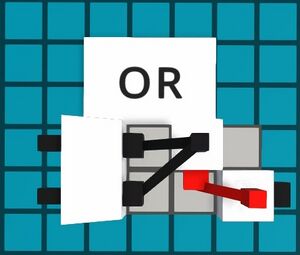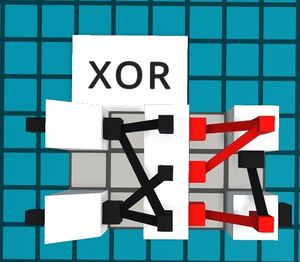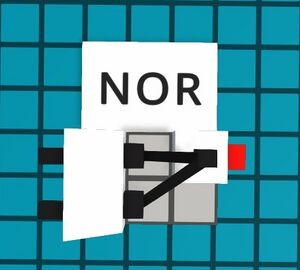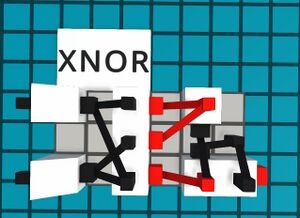Inverter Logic Gates: Difference between revisions
FoxFireFive (talk | contribs) Created page for Inverter Logic Gates. |
FoxFireFive (talk | contribs) m made a typo in the inverter xnor section |
||
| Line 65: | Line 65: | ||
== Inverter | == Inverter XNOR Gate == | ||
An '''XNOR Gate''' is a basic digital logic component whose output will be '''ON''' if all inputs are the same. | An '''XNOR Gate''' is a basic digital logic component whose output will be '''ON''' if all inputs are the same. | ||
Revision as of 19:10, 7 September 2025
Logic gates can be created using only the Inverter component and the Buffer component, with the exception of pegs for routing.






Inverter AND Gate
An AND gate is a basic digital logic component whose output will be ON if all its inputs are ON.
The Inverter AND gate's output will only be active if all of its inputs are ON. This is true no matter how many inputs the Inverter AND gate has.
To add more inputs, connect more inverters to the output inverter.
The Inverter AND gate has a latency of 2 ticks, so in the instance when all inputs are ON, the output will become active 2 ticks later.
Inverter OR Gate
An OR Gate is a basic digital logic component whose output will be ON if any of its inputs are ON.
The Inverter OR gate's output will be active if any of its inputs are ON. This is true no matter how many inputs the Inverter OR gate has.
To add more inputs, connect more buffers to the first inverter.
The Inverter OR gate has a latency of 3 ticks, so in the instance when all inputs are ON, the output will become active 3 ticks later.
Inverter XOR Gate
An XOR Gate is a basic digital logic component whose output will be ON if only one input is ON.
The Inverter XOR gate's output will be active if only one of its inputs are ON.
The Inverter XOR gate has a latency of 3 ticks, so in the instance when all inputs are ON, the output will become active 3 ticks later.
Inverter NAND Gate
A NAND gate is a basic digital logic component whose output will be OFF if all its inputs are ON.
The Inverter NAND gate's output will only be inactive if all of its inputs are ON. This is true no matter how many inputs the Inverter NAND gate has.
To add more inputs, connect more inverters to the top-right inverter.
The Inverter NAND gate has a latency of 3 ticks, so in the instance when all inputs are ON, the output will become inactive 3 ticks later.
Notice the peg behind the bottom-right inverter, it is to make the Inverter NAND gate more compact.
Inverter NOR Gate
A NOR Gate is a basic digital logic component whose output will be OFF if any of its inputs are ON.
The Inverter OR gate's output will be inactive if any of its inputs are ON. This is true no matter how many inputs the Inverter NOR gate has.
To add more inputs, connect more buffers to the first inverter.
The Inverter NOR gate has a latency of 2 ticks, so in the instance when all inputs are ON, the output will become inactive 2 ticks later.
Inverter XNOR Gate
An XNOR Gate is a basic digital logic component whose output will be ON if all inputs are the same.
The Inverter XNOR gate's output will be active if all of its inputs are the same.
If both of its inputs are ON, its output will be active, and if both of its inputs are OFF, its output will be active, and if only one of its inputs are ON, the output will be inactive.
The Inverter XNOR gate has a latency of 4 ticks, so in the instance when all inputs are ON, the output will become active 4 ticks later.
Notice the peg above the bottom-right inverter, it is to help with routing.

